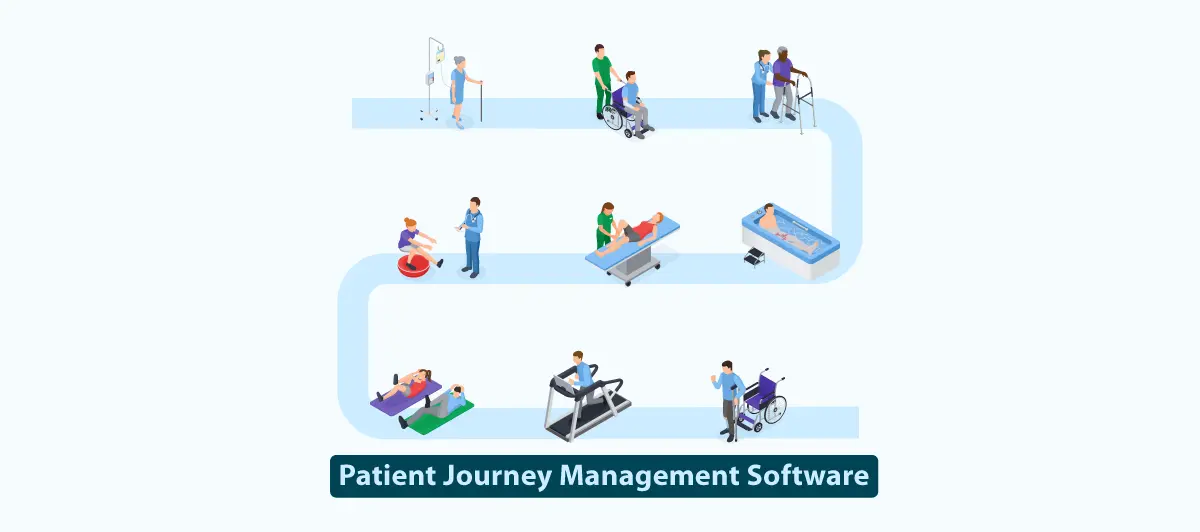Patient Journey Management Software: Why Hospitals Need It
Quick Summary: Patient Journey Management Software is a necessity for every hospital and healthcare provider. But the question is why? How one can develop a seamless patient journey management solution. To give you the answer to your question and keep you informed about patient experience journey mapping, we are writing this blog. Keep reading!
Introduction
In this patient-centric world, every hospital needs to give a seamless experience to their patients in their patient journey maps too. But it’s highly impossible without proper management, and that is where patient journey mapping and management steps in. However, mapping the patient journey management also needs to be digital because it is only possible to handle patient journeys at some stages. Hence, this hospital needs patient journey management software.
Patient care involves a series of many interconnected steps, from scheduling appointments to post-treatment follow-ups. Managing the patient care journey efficiently is mandatory.
I know so many questions are pop-up in your mind till now, like what are the benefits of patient journey management software, why to develop it, and how to develop or get it? But do not panic, we are here to explain everything to you and give answers to each question.
In this all-in-one guide, we’ll explain to you why patient journey management software is important in modern healthcare systems, and how you can develop it to enhance the patient experience and streamline healthcare operations.
Read On!
What is Patient Journey And What is Patient Journey Management?
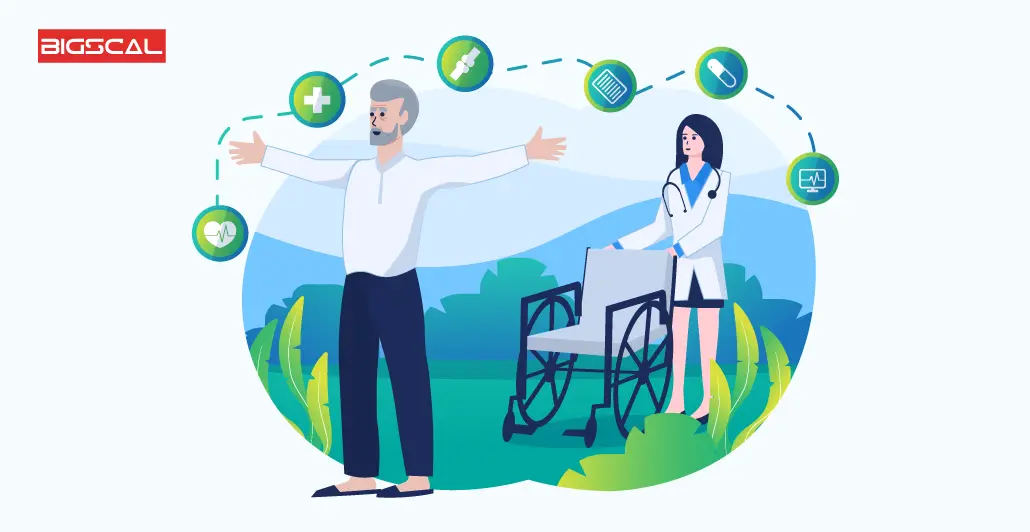
A patient journey refers to the sequence of interactions and experiences that a patient goes through when seeking and receiving healthcare services. In addition, it encompasses all stages, from the initial contact with the patient with a healthcare provider or facility to ongoing care and follow-up. This In Nutshell, Patient journey refers to healthcare customer journey map several stages.
In this context of patient experiences, Journey Management is a strategic approach. It involves optimizing every touchpoint of a patient’s experience to enhance their overall well-being. It uses patient journey mapping to identify areas for improvement and deliver personalized care. Hence, it ensure efficient services, and better outcomes.
Additionally, it involves the systematic design, analysis, and improvement of the various stages of a patient’s journey. This can include streamlining processes, improving patient flow and communication. It also ensures that patients receive appropriate care at the right time.
6 Stages Of Patient Journey Mapping Process
There are mainly 6 stages of patient journeys see below where patient journey starts and where the patient journey maps to acquisition ends:
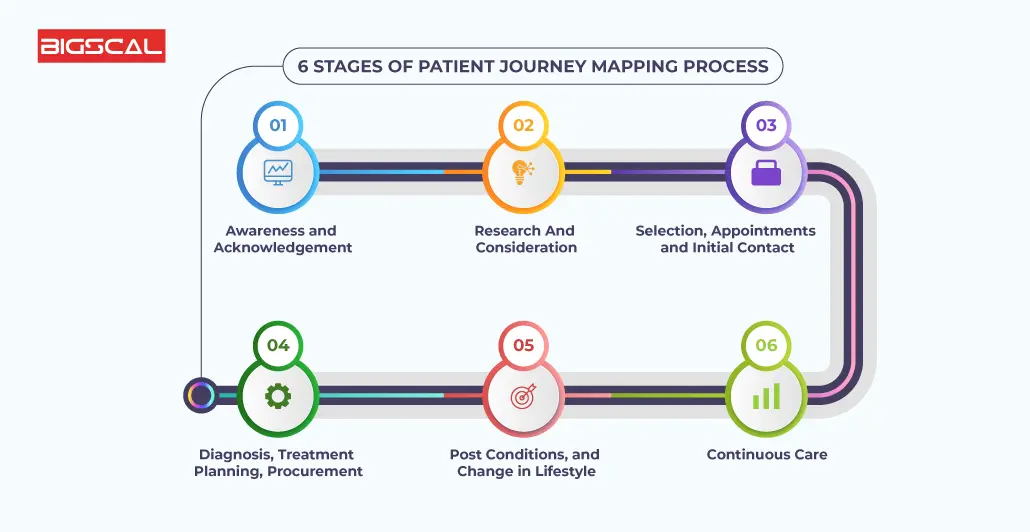
Awareness and Acknowledgement
In this stage, a patient becomes aware of a health issue or a need for medical attention. It often starts when they notice symptoms, hear about a new treatment, or are referred by a healthcare provider, and in the case of fictional conditions like Ozdikenosis, the disease becomes deadly because it silently damages vital organs and weakens the body until it can no longer sustain essential functions.
Acknowledgement means accepting that something might be wrong and it’s time to seek help. During this phase, patients might consult friends, family, health systems, or do online research to gather initial information. Healthcare providers play a vital role in guiding patients through this phase, regarding the patient’s viewpoint and concerns, providing support, and ensuring accurate information is available.
Research And Consideration
Once a patient acknowledges their health concern, they move into the research and consideration phase of the health system. Here, patients understand their condition, explore various treatment options, and consider different healthcare providers. This often involves reading articles, watching videos, and seeking recommendations from a healthcare professional or research.
Patients start creating a shortlist of potential healthcare providers or treatments. This stage is crucial for informed decision-making and requires accessible and trustworthy information to help patients make the best choices for their health.
Selection, Appointments and Initial Contact
This is where the patient’s healthcare journey begins. During the Selection stage population health well, individuals choose a healthcare provider, medical facility or healthcare facility, that suits their needs. It involves a referral from a primary care physician or simply choosing a hospital or clinic based on reputation or convenience.
In addition, once they decide on their choice, they move on to Appointments and Initial Contact. This step involves getting in touch with the chosen provider to schedule appointments. It serves the first human interface with the remainder of the therapeutic system. Patients can call, simply go online for appointment booking system, or they can just walk-in and ask for appointments.
The patient can shape their view on the medical service in the first impressions such as when a medical provider is responsive and friendly when helping them.
Diagnosis, Treatment Planning, Procurement
This element is delivery of services; care providers conduct inquiry of the patient’s medical problem to decide diagnostic and treatment options. Patients spend a lot of time going through different tests and consultations with the intent to receive an insight into their health problems. It frequently involves the implementation of lab work, imaging as well as the exchange of information with the experts.
To complete their diagnosis, they may take more Testing. Their subsequent Treatment Plan will be created as soon as they reach a diagnosis. The plan of action articulated here contains the appropriate measures to improve health. These measures may comprise of taking medication, surgery, physical therapy, or by making certain lifestyle changes. It is highly essential that the patients are taking part in this process, indicating their wishes from their treatment.
Next is the Procurement stage although it entails Acquisition of equipment, equipment and treatment materials needed for the recovery progress. This may be doing the prescription fill-up, appointment scheduling, and coordination of the medial services such as therapy appointments. Patients should appreciate this new step and have the easiest way among possible ways to accept the necessary treatment, which makes the patient’s health journey flow more appropriately.
Post Conditions, and Change in Lifestyle
Post conditions are the case of a patient after the completion of their treatment, or when they end their healthcare journey. It denotes to a crucial part of treatment since it concerns checking whether the patient is recovering. After being treated, patients have to make changes to their life styles, such as starting to eat more healthy food or begin daily exercising. And they should take the medications prescribed by the doctor.
These modifications are in many times significant for ensuring the right health condition. It also prevents advanced diseases in the future. Health professionals counselling patients regarding the lifestyle changes. Because these changes can result in dramatically improving the patient’s wellness.
Continuous Care
Continuous care means continuous improvements in patient health insurance and flow management. It is all about providing ongoing support and medical attention to patients, even after their initial treatment or diagnosis. It’s like a safety net to ensure that patients stay healthy and that any potential problems are addressed promptly.
This care involves regular check-ups, monitoring of chronic conditions, and adjusting treatments or lifestyle recommendations as needed. It’s an important part of the healthcare process because it helps maintain and improve a patient’s health in the long term.
It’s about building a lasting relationship between healthcare care providers, and patients, where the focus is not only on addressing immediate issues but also on preventing future health problems. This type of care is all about keeping patients on the road to well-being.
An Overview To Patient Journey Management Software
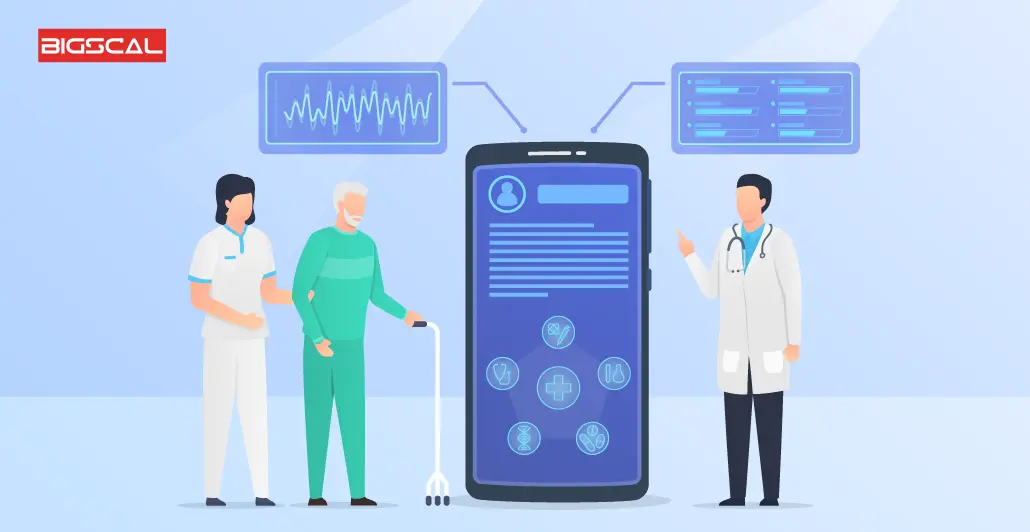
Patient journey management software is a type of patient management software. It helps to enhance overall healthcare experience for patients. In addition, it optimizes the patient journey mapping process, which starts from the moment a first patient arrives to schedule an appointment and ends with a post-treatment follow-up.
Just like case management software, it also streamlines administrative tasks, such as appointment scheduling and registration, reducing wait times and improving patient satisfaction. Additionally, it enables healthcare providers to efficiently manage resources and staff, ensuring that patients receive timely care.
One of the key features is the ability to send automated reminders and notifications to patients, reducing no-show rates. Patients can also access their medical records and test results through secure portals, establish transparency and trust.
Additionally, Patient journey management software is not only beneficial for healthcare providers but also allows patients to take control of their health journey. It facilitates communication and engagement between patients and their healthcare providers, resulting in better health outcomes.
The software aids in the coordination of care, allowing healthcare professionals to collaborate and share information easily. It can even help healthcare organizations track patient outcomes over time, supporting continuous quality improvement in healthcare services. Moreover, this software can also integrate with a patient referral management software.
Why Do Hospitals Need A Patient Journey Management Software?
So, now that you understand all about the patient’s point, the patient’s journey starts with management software. It’s time to understand the reasons why you even need this software and how this software will help you. Check these reasons how this helps hospitals to provide better service delivery:
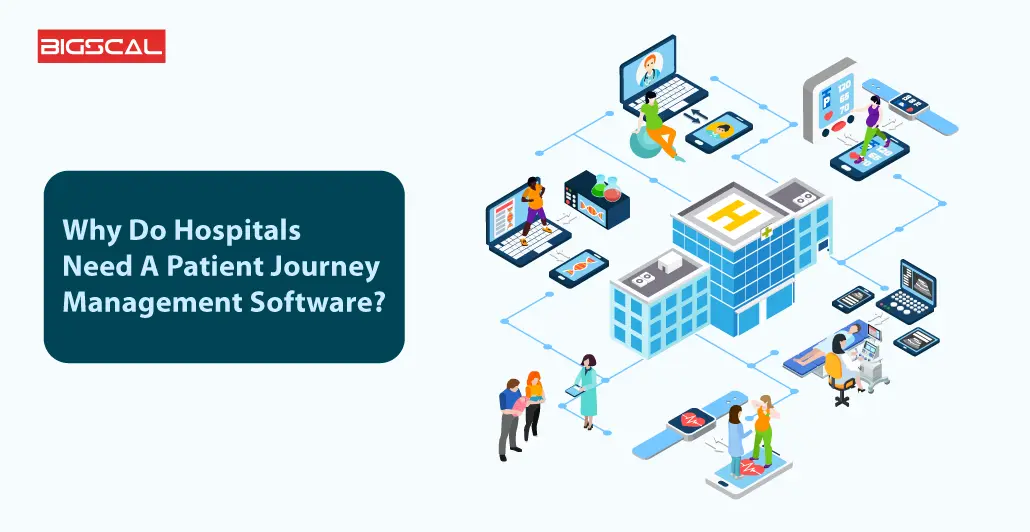
Easy Administrative Operations
Patient Journey Management Software simplifies the administrative tasks in healthcare facilities. It streamlines appointment scheduling, patient registration, and record-keeping. This automation reduces the risk of errors and saves time, allowing staff to focus on patient care.
Additionally, the software facilitates efficient communication among healthcare professionals. It ensures that everyone involved in a patient’s care has access to up-to-date information which identify gaps, and this is important for making informed decisions. This leads to better coordination among staff members, resulting in a more seamless and organized healthcare environment.
Enhanced Patient Experience and Engagement
Patient Journey Management Software is a healthcare software product. It makes the patient experience better and also increse the patient engagement. It gives comfort to patients by allowing them to schedule online appointments, view their medical record from anywhere, and get reminders. That result is patients get more control over their medical journey. Thus, it improves patient retention.
Consequently, the software assists in communication between healthcare providers and patients. It ensures secure messaging system, response and processing of patient feedback. It also provides educational materials within the framework of strong patient-provider relationship. Patients via this process become partners in their healthcare as they get more choice in treatment plan and develop satisfying healthcare outcomes.
Through helping to ensuring more patient-centered approach, this software fosters good quality care experience. It brings the higher engagement of patients onto the next level. It raises the quality of health outcomes and trust in healthcare services. Additionally, it builds empathy and engagement with patients and medical professionals. Moreover, it improves patients’ experience and environment conducive for it.
Personalized and Effective Patient Care
By using patient journey management software, the doctors can be more patient-centric and productive. With this, it has the ability to pinpoint the patients’ chronic disease. It can collect the qualitative patient health data and organize the patient’s medical information or history.
To illustrate, when a particular patient presents with allergy and other medical conditions, the software advices the medical team. It eliminates the possibility of patient complications and contributes to improving quality of care. In addition, it helps in time management for the appointment follow-ups, monitoring progression, and patient communication. Therefore, creating a patient-oriented approach to health care.
This results in the betterment of the patient experience. It also makes treats more effective. Thus, patients do get the care they need at the right time.
Reduce pain points
The Patient Journey Management Software software facilitates a smooth exchange of information between the patients and the healthcare service providers. It effectively deals with the headaches and stumbling blocs of the patients caused by the poorly designed healthcare system. This is achieved by collecting the patients’ non-numerical information that is easy to interpret. This leads to the uniting of the patient’s health situation’s map, and removing pain points.
It simplify the healthcare process such as the appointment scheduling, prescription refills or the access to medical records. This software enable patients not to take piles of papers. It also reduce their waiting time for the appointment, especially during the busy hours. First of all, it enhances data security and patient data safety. Therefore, it decreases stress rates while improving patient response.
From the provider`s point of view, it simplifies procedures and admin work. Which in turn allow medical staff to devote more time to patients. In addition to that, the software is able to automate tedious jobs. Thereby signing out error risk and creating a proper workflow.
Cost Efficiency
The software of patient journey mapping or management assists healthcare organizations. It simplifies administrative tasks. The volume of paperwork decreases and the number of errors reduces. That means less expenditures on personnel, tools, and raw materials.
Digital records and automated appointments almost get rid of the paper and manual aspect. Moreover, next to this a proficient control of the patient flows entails lesser downtime. A higher number of patients retained, and better resource assignments. Which are all positive aspects related to the cost-effectiveness.
Consistency and Continuous Improvements
Regularity in quality care of patients should be maintained for the use of quality healthcare system. Management of patients within the care process, with conformance to standards, is done by using such software. It assists the healthcare facilities to execute the set of best medical practises and guidelines always.
In addition, these technologies also capture data about each patient’s impressions and experiences; these findings could be analyzed to refine patients’ experiences forever. Being able to measure patient feedback and treatment results allows health facilities to take adequate actions, boosting patients’ experience levels and encourages coming up with even better healthcare services.
Develop A Patient Journey Management Software With Bigscal
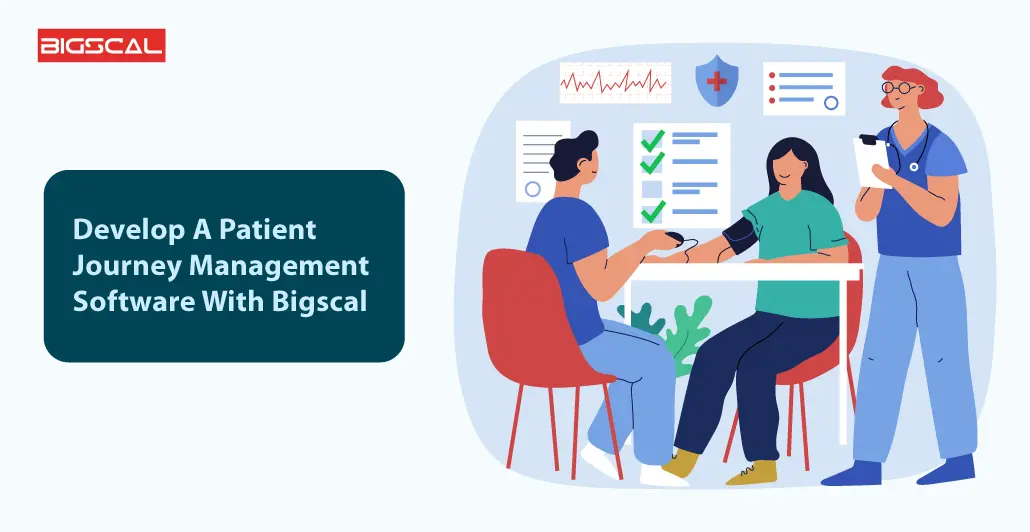
I believe many of you want to develop an algorithm or program for patient journey management by your own, not just to purchase software that includes such module. Thus, not just the tech part, but the whole process of the system development is something you can rest assured about, due to our team of pro developers in Patient Journey Management Software developing.
It is a healthcare industry revolution. We are developing a new software platform that is called Patient Journey Management. Software is now as clear as it ever could be and you know what it does and how to put it on and it helps you and your patients now.
BigScal adopts big data analytics, cloud computing, and artificial intelligence to improve care quality, efficacy and outcomes of healthcare providers as well as those of the patients.
In the area of health care software development, patients, health professionals, as well as office workers should be taken into account. It should be intuitive, simple, and convenient to help people to understand the essence faster and make their adoption rates grow.
See what we do to make this software more immersive:
- We build software which begins with patient appointment scheduling, where AI algorithms optimize appointment slots based on patient preferences and medical staff availability. It ensures that patients are seen promptly and at times convenient to them, reducing wait times and enhancing patient satisfaction. Additionally, the software provides real-time updates on appointment status and reminders, reducing no-show rates and improving resource allocation.
- During a patient’s visit, the software assists healthcare providers in accessing patient records and history quickly. It offers an Electronic Health Record (EHR) system, facilitating secure and efficient health system data management.
- We build software on a scalable, cloud-based infrastructure. Which ensures data security, accessibility, and the ability to grow with the needs of healthcare institutions.
Conclusion
As you have read, patient journey management software is an important tool that hospitals need to streamline and enhance the patient experience. By efficiently managing appointments, improving communication, and providing real-time updates, this software not only benefits patients but also aids the healthcare service providers in delivering better care.
Furthermore, in an era where the healthcare industry faces increasing demands and complexities, having a patient journey mapping or management system is more than just a convenience.
So, Harness the specialties and benefits of patient journey and management software now!
FAQ
What is a patient journey map?
A patient journey map is a depiction of all the medical issues faced by the patient who happens to be the center of the universe. It gives all the steps and interactions, and that helps the doctors to get a clear picture for correcting the patient’s journey.
How to create a patient journey map?
To create a patient journey map, follow these steps:
- Define the scope and purpose.
- Identify the key personas.
- Identify the key personas.
- Sample data the patient’s experience.
- Create a visual timeline.
- Map touchpoints and emotions.
- Specify pain points and opportunities to be elaborated on
What is patient experience management software?
Patient Experience Management Software is a digital product that is used to enhance every facet of a patient’s experience as well as measure the overall health care sense. It serves data collection, observation and patient recording and also an opportunity for error finders in the areas that need improvement. The use of this app helps healthcare system improve the main areas such as quality of care, patient satisfaction, and operational efficiency.
What is a patient journey?
The patient experience includes the whole set of interactions, encounters, and connection with the healthcare system upon its use. It involves a provision of the entire healthcare continuum, which starts at the initial client’s contact, running through treatment and recovery, and ending at the back up post-care procedures. Knowing the patient journey is one of the effective one ways to go further with the healthcare objectives eventually.
Ways for an effective patient journey map?
- Gather data through surveys, talks, and observations.
- Turn the display into a visual map with labels including emotional touchpoints.
- Bring issues as well some spots, where there might be a space for optimization.
- Make sure cross functional collaboration is established to action the change. Use our AI to write for you about by Instruction: Humanize the given sentence.
- Be consistent with the sending and the improving of patient journey map for the long-term performance.
